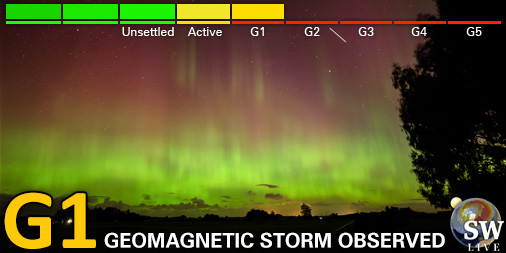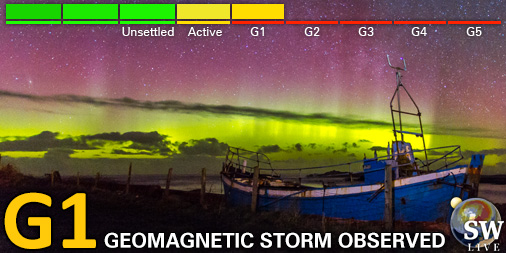Het archief bekijken van donderdag 19 juni 2003
Activiteitenrapport
Bij elke genoemde zonnevlam in dit rapport werd een schaalfactor toegepast door het Space Weather Prediction Center (SWPC). Vanwege de SWPC-schaalfactor worden zonnevlammen 42% kleiner gerapporteerd dan voor de wetenschappelijke data. De schaalfactor werd verwijderd uit onze gearchiveerde zonnevlamdata om de werkelijke fysieke eenheden weer te geven.
Rapport van de zonne- en geofysische activiteit van 2003 Jun 19 2200 UTCOpgemaakt door de NOAA © SWPC en verwerkt door Poollicht.be
USAF/NOAA rapport van de zonneactiviteit en geofysische activiteit
SDF Nummer 170 gepubliceerd omstreeks 2200Z op 19 Jun 2003IA. Analyse van de actieve zonneregio's en zonneactiviteit van 18-2100Z tot 19-2100Z
Solar activity decreased to very low levels. Flare
activity was limited to several B-class flares. Region 386 (S07E30)
lost penumbral coverage over the period although it does retain a
delta magnetic structure in the dominant lead spot. Region 387
(N18E49) grew in both penumbral coverage and magnetic complexity
since yesterday, a gamma structure is now evident in the trailing
portion of the spot group. Newly numbered Region 388 (S03E08)
produced a minor B-class flare early in the period.
IB. Voorspelling zonneactiviteit
Solar activity is expected to be at
moderate levels. Region 386 remains capable of producing an
isolated major flare.
IIA. Samenvatting geofysische activiteit 18-2100Z tot 19-2100Z
The geomagnetic field was at predominantly active levels today.
Minor storm conditions were observed at both middle and high
latitudes between 19/0000 and 0300Z due to the influence of a
recurrent high speed coronal hole stream. The greater than 10 MeV
proton flux exceeded event threshold at 18/2050Z (reached a max of
24 pfu at 19/0450Z), ended at 19/1900Z and after careful review the
event is believed to have been the result of the M6.8 x-ray flare
from June 17. The greater than 2 MeV electron flux reached moderate
levels today.
IIB. Voorspelling geofysische activiteit
The geomagnetic field is
expected to be at predominantly unsettled to active levels through
the interval. Minor storm conditions may exist due to a transient
passage during the first half of day one in response to the M6.8
x-ray flare from June 17.
III. Kans zonnevlammen van 20 Jun tot 22 Jun
| Klasse M | 50% | 50% | 50% |
| Klasse X | 15% | 15% | 15% |
| Proton | 25% | 15% | 15% |
| PCAF | green | ||
IV. Penticton 10.7 cm Flux
Geobserveerd 19 Jun 123 Voorspeld 20 Jun-22 Jun 125/125/125 90 dagen gemiddelde 19 Jun 124
V. Geomagnetische A index
Geobserveerd Afr/Ap 18 Jun 036/054 Geraamd Afr/Ap 19 Jun 023/025 Voorspeld Afr/Ap 20 Jun-22 Jun 020/025-020/025-012/020
VI. Kansen op geomagnetische activiteit van 20 Jun tot 22 Jun
| A. Gemiddelde breedtegraad | |||
|---|---|---|---|
| Actief | 40% | 40% | 25% |
| Kleine storm | 15% | 15% | 10% |
| Zware-ernstige stormcondities | 10% | 10% | 05% |
| B. Hoge breedtegraad | |||
|---|---|---|---|
| Actief | 50% | 50% | 40% |
| Kleine storm | 20% | 20% | 15% |
| Zware-ernstige stormcondities | 10% | 10% | 10% |
Alle tijden in UTC
<< Keer terug naar de dagelijkse overview pagina
Op basis van de huidige parameters is er nu geen kans op poollicht in België en Nederland
Laatste nieuws
Laatste forumberichten
Suggesties? 8Noorderlicht kans 6-1-2025 2Poollicht 1 januari 2025 2Naar Noorwegen in Maart? 3Noorderlicht kans 10/11-10-2024 56
Meer forumberichtenSteun Poollicht.be!
Om ook bereikbaar te blijven bij grote poollichtkansen hebben we een zware server nodig die alle bezoekers aankan. Doneer en steun dit project zodat we online blijven en je geen enkele poollichtkans mist!

Laatste alerts
15:09 UTC - Hemisferisch vermogen
Het OVATION-model voorspelt dat het hemisferisch vermogen 50GW zal bereiken om 15:48 UTC
08:00 UTC - Geomagnetische activiteit
G1 - Kleine geomagnetische storm (Kp5) Drempel bereikt: 07:52 UTC
zaterdag 3 mei 2025
10:45 UTC - Geomagnetische activiteit
G1 - Kleine geomagnetische storm (Kp5) Drempel bereikt: 10:30 UTC
08:57 UTC - Hemisferisch vermogen
Het OVATION-model voorspelt dat het hemisferisch vermogen 76GW zal bereiken om 09:32 UTC
01:00 UTC - Geomagnetische activiteit
G1 - Kleine geomagnetische storm (Kp5) Drempel bereikt: 00:55 UTC
Ruimteweer feitjes
| Laatste X-klasse uitbarsting | 28/03/2025 | X1.1 |
| Laatste M-klasse uitbarsting | 30/04/2025 | M2.03 |
| Laatste geomagnetische storm | 03/05/2025 | Kp5 (G1) |
| Zonnevlekkenloze dagen | |
|---|---|
| Laatste zonnevlekkenloze dag | 08/06/2022 |
| Maandelijks gemiddeld zonnevlekkengetal | |
|---|---|
| april 2025 | 140.6 +6.4 |
| mei 2025 | 58 -82.6 |
| Afgelopen 30 dagen | 114 -17.5 |





